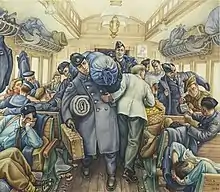Paul Goranson
Paul Goranson (April 27, 1911 – August 3, 2002) was an official Canadian war artist. Goranson worked with the Royal Canadian Air Force and was noted for the exactness of his pictures and the fearless way he worked under fire during World War II.[1] His favorite subject, besides the pilots themselves and their life, was the relationship of men with machines.[2]
Paul Goranson | |
|---|---|
| Born | Paul Alexander Goranson April 27, 1911 Ottawa, Ontario |
| Died | August 3, 2002 (aged 91) Vancouver, British Columbia |
| Nationality | Canadian |
| Education | Vancouver School of Art (1931-1932) and the British Columbia College of Art (1932-1934) with F. H. Varley; Art Students League, New York (1949-1950) with Robert Brackman and Will Barnett |
| Known for | Painting, print-making, Set Design for the Metropolitan Opera, New York (1966-1986) |
Biography
Goranson was born in Ottawa, Ontario, in 1911. After attending the Vancouver School of Art (today Emily Carr University of Art and Design) and the British Columbia School of Art (1931-1934) where he received full training in drawing the figure from F. H. Varley, Goranson worked as a portrait artist and commercial artist.[1]
With fellow Vancouver artists Orville Fisher and E. J. Hughes (the trio called themselves the West Coast Brotherhood, echoing the Pre-Raphaelite Brotherhood), he painted several mural paintings.[1][3] Drawing inspiration from the bold colours of the Mexican artist Diego Rivera and from the heroic style of the American Thomas Hart Benton, the trio executed a series of large panels for a cabaret restaurant in Vancouver's Chinatown and murals for a church.[1] They then produced a series on the industries of British Columbia for a 12-part mural at the British Columbian pavilion at the 1939 San Francisco World’s Fair, the Golden Gate International Exposition.[1][3] Goranson also worked on murals at the Malaspina Hotel, Nanaimo, later covered over by renovation work.[4]
As a graphic artist and printmaker of merit, Goranson joined the Canadian Society of Graphic Art. He also taught drawing at the Vancouver School of Art at nights (1936-1941) and taught print-making, during the summers from 1937 to 1940.[5] In 1941 Goranson had a solo exhibition at the Vancouver Art Gallery.[4]

In 1941 he joined the Royal Canadian Air Force and two years later—after receiving his commission as a war artist—became the first Air Force artist to be sent overseas. Under the influence of the watercolors and paintings of Carl Schaefer and the technically superior work of Charles Comfort, Goranson’s own work became freer.[2]
On Goranson’s trip to England in March 1943, his ship, the 5,000-ton banana boat SS Tucurinca, was torpedoed 250 miles south of Iceland. The torpedo struck in the early evening while Goranson was busy sketching the ship’s chief engineer. Despite a rough sea and lurking U-boats, the passengers and crew were rescued from their sinking ship by another ship and eventually taken to Glasgow, Scotland.[2] Goranson used this experience to sketch himself in an open boat.[1][6]
While overseas he painted Bomber Command activities before going to Tunisia and Italy in August 1943. From July 1944 to spring of 1945, he painted scenes with the Tactical Air Force in Northwest Europe. He remained overseas until 1947 because he felt he had work to complete from pencil sketches he'd made while out in the field.[2] Goranson said it was amazing how the war had launched him as an artist. He noted that during the war he released himself from the near stylized work he was doing. He began to see new directions in his work.[2]
The artist spent two years in Ottawa after the war, then, finding no work in Toronto, he went to New York where he ran a company which provided window displays for department stores such as Macy's and Gimbels.[1] From 1966 until his retirement in 1986, he worked at the Metropolitan Opera as a scene painter.[1][6] After he retired, he returned to live in Vancouver.[2] In 2000, his work was included in the Canadian War Museum`s major exhibition Canvas of War: Masterpieces from the Canadian War Museum.
Goranson died in Vancouver in 2002, at the age of 91.[1][6][7]
Collections and archives
His work is in the National Gallery of Art, London, England;[8] the Brooklyn Museum, New York;[9] the National Gallery of Canada, Ottawa;[10] and the Canadian War Museum (which holds 131 of his works on permanent display).[6][11]
In the Vancouver Art Gallery library, there is a three page letter from Goranson to Gallery Director J.A. Morris, dated Feb. 19, 1950, in which he talked about his life and artwork.[4]
References
- "Paul Goranson". www.telegraph.co. The Telegraph, 13 September 2002. Retrieved October 19, 2020.
- Morse, Jennifer. "Paul Goranson". legionmagazine.con. Legion Magazine May 1, 1996. Retrieved October 19, 2020.
- "Three young artists paint Vancouver for the world". The Province. March 25, 1939. p. 50. Retrieved October 25, 2020.
- Goranson, Paul Alexander. "Art & Artists in Exhibition: Vancouver 1890 – 1950". sim-publishing.com. Sim Publishing. Retrieved October 20, 2020.
- MacDonald 1968, p. 292-293.
- Mackie, John (August 10, 2002). "Artist captured horrors of war". The Vancouver Sun. p. 4. Retrieved October 25, 2020.
- Laucius, Joanne (September 15, 2002). "Former air force artist captured the face of war". The Ottawa Citizen. p. 11. Retrieved October 25, 2020.
- Goranson, Paul. "Untitled (Park Avenue), c. 1940". www.nga.gov. National Gallery of Art, London. Retrieved October 19, 2020.
- Goranson, Paul. "Third Avenue "L"". www.brooklynmuseum.org. Brooklyn Museum. Retrieved October 19, 2020.
- "Paul Goranson". National Gallery of Canada. Retrieved October 19, 2020.
- Goranson, Paul. "Posted to Newfie, 1942". www.warmuseum.ca. Canadian War Museum, Ottawa. Retrieved October 19, 2020.
Bibliography
- MacDonald, Colin S. (1968). A Dictionary of Canadian Artists (Third ed.). Ottawa: Canadian Paperbacks Publishing. Retrieved October 19, 2020.
- Murray, Joan (1983). Canadian Artists of the Second World War. Oshawa: Robert McLaughlin Gallery. Retrieved October 20, 2020.